Compiled by Joseph Svinth. Newspaper research by Patrick Baptiste, Rod Masuoka, and Curtis Narimatsu. Photographic research by Paul Lou and Curtis Narimatsu; all images copyright Paul Lou and Curtis Narimatsu, and used by permission. The assistance of Thelma Gora, the Japanese American National Museum, and Michael Machado of the Hawaii State Boxing Commission is also gratefully acknowledged.
The youngest of ten children (six boys and four girls), Antone Matsugoro was born at Waialua, Oahu on July 2, 1909. His father, Segiwara Matsugoro, was from Yamaguchi, Japan while his mother, Mary Silveira Figueira, was from Funchal, Madeira, Portugal. Matsugoro had come to Hawaii at the age of 37 while Figueira came at the age of 14, and the couple had met while working together in the cane fields.
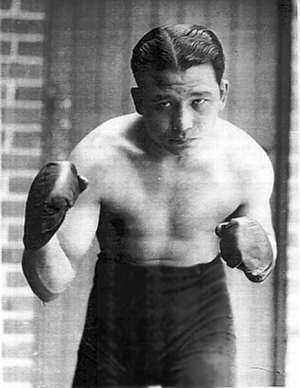
Tony Gora.
In February 1923 the Matsugoro family home was mentioned in the Honolulu Star-Bulletin as being destroyed by a tsunami. Other than that, little is known of Gora's childhood. Apparently, though, he visited Japan as a youth, as years later he told his wife that while in Japan, he had gone running in a park called Gora Park, and upon returning to Honolulu had decided to change his name to Gora. All his siblings except his oldest brother also eventually took the last name of Gora.
Gora grew up big, strong, and fast, and after Congress legalized professional boxing in Hawaii, a Honolulu sport named Henry Johnson talked him into turning pro.
Hawaii's first fight under commission rules took place at the Honolulu Stadium on August 13, 1929. The matchmaker was Chang Kau, who worked at the Navy Yard and was the elder brother of boxer Dick Chang, and the referee was Dr. Francisco D'Eliscu, who later wrote a book on hand-to-hand fighting for the Army. Most of the early fights pitted the Army versus the Navy, but Japanese versus Filipino was another popular match-up. And, as boxing is a gambler's sport, a popular cry heard from the crowd during these fights was always "Go for Broke!"
Gora's first professional fight took place on September 21, 1929. The opponent was Charlie Rosa, and Gora lost a 4-round decision. But he won his next seven fights, six by knockout, and as a result soon moved into the semi-finals and main events. Financially, this was an important move, for as a preliminary fighter he sometimes received as little as $18.40 per fight, but as a victorious main event fighter, he earned between $200 and $400 per fight, which was good money for a working man during the Depression.
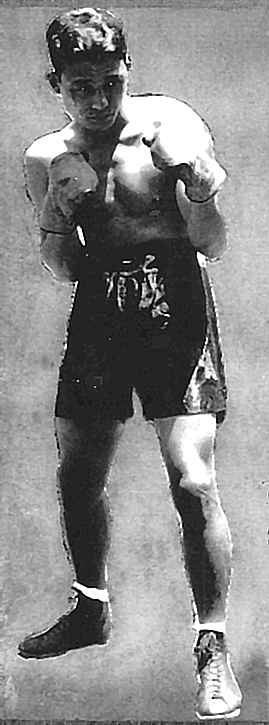
Publicity still from 1929-1930 showing Gora at 160 pounds
Depending on how hard he had been training, Gora fought at various weights between 160 and 175 pounds. His best fighting weight, however, was around 168. He had a good right hand, and in January 1931 the Honolulu sportswriter Don Watson said that Gora was the Territory's best middleweight. And, believing this, Gora went to San Francisco that very month.
In California, Gora's manager and trainer was Billy Newman, a man who handled many Hawaiian fighters. Of Gora's seven known fights on this tour -- he probably had more -- he won five, drew one, and lost one. But middleweights with good rights were not uncommon in California and as a result his pay averaged just $100 per fight, which was half what he was used to in Hawaii. As a result, said Gora's friend Togo Nakamura, the money was usually gone within a few days.
Broke, Gora returned to Hawaii during the spring of 1931. Billy Newman later told sportswriter Red McQueen he could have killed Gora for that, as it seems that Gora had caught the first ship out of town without bothering to tell his trainer that he was leaving.
Immediately upon returning to Hawaii, Gora began dating the boss's daughter. In 1929 the Honolulu building contractor Joseph F. Neves had built the 5,000-seat Houston Arena in Palama. (The name honored Territorial Delegate to Congress Victor Houston, who introduced the bill into Congress that got boxing legalized in the first place.) [EN1] Neves' daughter Thelma worked in the office at the Civic Auditorium, where Neves also promoted boxing. "Tony would not leave me alone, so we dated," recalled Thelma Gora in August 2000.
Gora had two fights in Honolulu during August and September 1931. After that he went to Manila, where his most important match was with Ceferino Garcia, a future world's middleweight champion, on November 14, 1931. While Gora lost in ten, the call was not popular, as even the Filipino fans thought Gora had been robbed of victory by bad officiating. "I knocked him all over the ring," Gora told Hardy Hutchinson of the Star-Bulletin in April 1952, and for the rest of his life he liked telling of the near riot that ensued following the announcement of the decision.
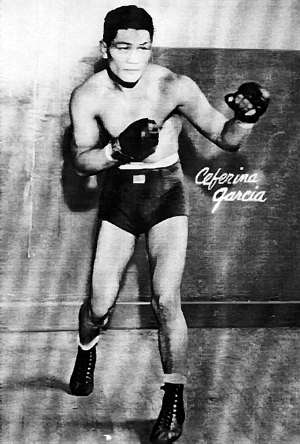
Ceferino Garcia
After winning two fights in Manila, Gora returned to Hawaii for Christmas. He resumed fighting in February, and had three victories in Honolulu between February and April 1932.

During April 1932, promoter Sam Feldman sent Gora a ticket to Australia and a promise of either $2,000 or 25 percent of the gates of three fights. Liking the sound of that, on May 12 Gora caught the SS Mariposa for Australia. Before he left, Gora also secretly married Thelma Neves.
Gora's first Australian fight took place in Sydney on June 30. The opponent was the Australian middle, light-heavy, and heavyweight champion Ambrose ("Kid") Palmer. Gora later recalled the match, which he lost, as being especially tough because it was the first time he had ever fought fifteen rounds. However, his most famous Australian fight took place in Adelaide on November 3, 1932. The opponent was the well-regarded US heavyweight William L. "Young" Stribling, who outweighed Gora by twenty pounds and boasted a career record of around 100 knockouts.
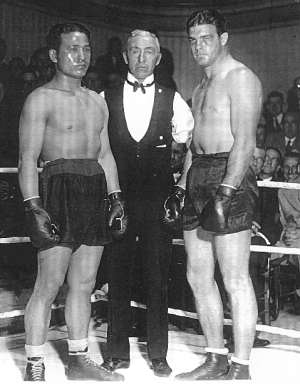
Tony Gora and William Stribling
"Stribling was one of the dirtiest fighters I ever met," Gora later told Sacramento sportswriter Bill Conlin:
You see, Stribling came into my dressing room before the fight. He had looked at the house, which was a small one, and said, 'I don't want to hurt you or beat you up, young fellow. So why not take the easy way. Go down for the long count in the first round and we can all go home early.' I told Stribling that I had never laid down in my life and he would have to knock me out. I would not quit.
'Have it your own way then,' was Stribling's parting shot as he left the room.
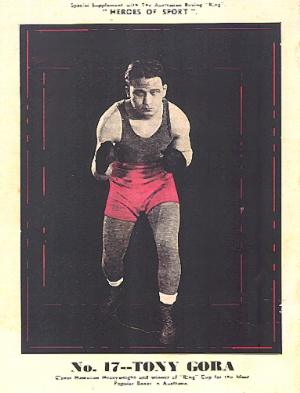
Publicity still from Gora's Australian tour
Unfortunately the Australian trip was not a financial success, and after deducting expenses Gora returned to Hawaii about as broke as he left. Which isn't surprising when it is remembered that after beating Billy Richards on September 17, Gora's winning percentage amounted to exactly $12.50. It was not a domestic success, either, for upon returning to Honolulu, Gora found one angry spouse. "The agreement was he would have three fights over there and then we would make the announcement," Thelma Gora later recalled. "But he remained there for about eight months and all the news I received from the fighters who got back to Honolulu was what a great time Tony was having over there. So when he got back I did not want any part of him. So he lived with his mother and I lived with my Dad and that was that for four and a half years."
Between March and June 1933 Gora won three fights and lost one. Thirty-seven years later, Red McQueen recalled his match with Art Costa as one of the bloodiest that he had ever seen. Said McQueen: "Tony stopped Art in the eighth round but not before nearly bleeding him to death -- from the mouth, nose, and about the eyes." Then, after losing a fight to Tiger Payne on June 2, Gora traveled with Sam Feldman, Henry Kudo, and Johnny Gabuco to Manila, where on August 12 he lost a fight to the Filipino heavyweight champion Luis Logan.
After that Gora went by himself to California. This time he trained haphazardly, and while he still earned about $100 a fight, he liked partying so much that he was always broke. In fact, he was so broke that one time after winning a fight in Sacramento he had to hop a freight to get to Reno for his next match. His last known professional fight was in San Francisco on April 30, 1934, and the result was a 4-round loss to Ray Actis.
Gora's incomplete career record -- several fights from his Mainland tour of 1933-1934 remain to be identified -- consists of 26 wins (13 by knockout, two by foul), 2 draws, and 13 losses. The loss to Young Stribling represents his only known defeat by knockout.
After retiring from the ring, Gora operated a taxi, and soon had several men working for him. But his heart wasn't in running a taxi company and so he bought a bar called "The College Inn."
During late 1936 or early 1937 Gora moved in with the Joseph Neves family. This was through his friendship with Neves, actually; his daughter hadn't mentioned the marriage to her father yet, and was still living at home, taking care of her younger brothers. (Neves' wife had passed away several years earlier.) After a bit of this Gora decided to rent an apartment on Waikiki and make a go of the marriage. "I said I would tell my Dad," Thelma Gora recalled.
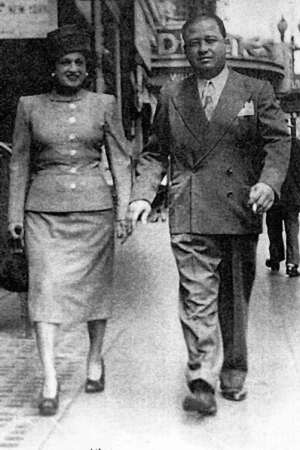
Thelma and Tony Gora, San Francisco, 1946
The couple had one son, Tony Jr., who was born on January 15, 1939. From 1994-1996 and 1998-2000, Tony Jr., a veteran of the US Army Airborne, served as mayor of Galt, California.
During World War II Gora Sr. operated a cocktail lounge called "Tony Gora's" and afterwards he ran "The Gold Room" on Bethel Street. Owning a bar was lucrative in Hawaii during World War II and the Korean War, and in 1954 Gora ran for the Honolulu board of supervisors on the Democratic ticket. It was a close race, but he lost and never ran for political office again. At home, "Tony was an excellent husband and later a father," Thelma Gora said. "I was very happy with him as he was so good to me."
Unfortunately Gora's health was failing, so in early 1961 he sold his Hawaiian property and moved with his wife to Galt, California, where he hoped the change of climate would improve his health. It didn't, and on April 1, 1970 he died of cancer, aged 61 years.
41 fights, with 26 wins (13 by knockout, two by foul), 2 draws, and
13 losses
| Date | Opponent | Location | Result |
| 1929 Sep 21 | Charley Rosa | Honolulu | L4 |
| 1929 Oct 11 | Johnny Flores | Honolulu | TKO2 |
| 1930 Jan 18 | V. "Big Boy" Fernandez | Honolulu | TKO1 |
| 1930 Feb 1 | Bert Quinn | Honolulu | KO1 |
| 1930 Feb 11 | Eddie Schmidt | Honolulu | TKO2 |
| 1930 Apr 18 | Andy Blahut | Honolulu | TKO2 |
| 1930 Apr 26 | W.J. "Spike" Worrall | Honolulu | WF4 |
| 1930 Sep 12 | Santos Troche | Honolulu | KO2 |
| 1930 Oct 3 | W.J. "Spike" Worrall | Honolulu | W6 |
| 1930 Dec 29 | Harry Gret | Honolulu | W8 |
| 1931 Feb 18 | Ralph Pancoast | San Francisco | TKO1 |
| 1931 Mar 6 | Jack Connell | San Francisco | D4 |
| 1931 Mar 27 | Jack Gilmore | San Francisco | W4 |
| 1931 Apr 27 | Jack Connell | San Francisco | L4 |
| 1931 May 13 | Larry Hoke | San Francisco | TKO2 |
| 1931 May 22 | Bill Lawrence | San Francisco | KO3 |
| 1931 May 28 | Dynamite Jefferies | Sacramento | TKO1 |
| 1931 Aug 9 | Dick Miller | Honolulu | KO1 |
| 1931 Sep 19 | Frank "Marine" Johnson | Honolulu | W6 |
| 1931 Nov 14 | Ceferino Garcia | Manila | L10 |
| 1931 Nov 28 | Young Schmeling | Manila | W10 |
| 1931 Dec 12 | Young Uzcudun | Manila | W4 |
| 1932 Feb 5 | Frank "Marine" Johnson | Honolulu | W6 |
| 1932 Feb 20 | A.P. "Young Aguilar" Manlapig | Honolulu | W8 |
| 1932 Apr 2 | Alfred "Gimlet" Watson | Schofield Bks, HI | D6 |
| 1932 Jun 30 | Ambrose "Kid" Palmer | Sydney, Australia | L15 |
| 1932 Jul 18 | Clyde Chestine | Sydney, Australia | L15 |
| 1932 Aug 27 | Adolf "Pickles" Heinz | Sydney, Australia | L10 |
| 1932 Sep 17 | Billy Richards | Queensland, Aust. | W15 |
| 1932 Sep 24 | Ron Richards | Queensland, Aust. | L15 |
| 1932 Nov 3 | William "Young"Stribling | Adelaide, Australia | TKO by 6 |
| 1932 Nov 18 | Bob Thornton | Sydney, Australia | W15 |
| 1932 Nov 29 | Yank Henneberry | Sydney, Australia | WF7 |
| 1933 Mar 31 | Art Costa | Honolulu | TKO8 |
| 1933 Apr 15 | A.P. "Young Aguilar" Manlapig | Wailuku, Maui | W8 |
| 1933 Apr 28 | Manuel Limas | Honolulu | KO4 |
| 1933 Jun 2 | Jack Payne | Honolulu | L6 |
| 1933 Aug 12 | Luis Logan | Manila | L10 |
| 1933 Nov 24 | Max Maxwell | San Francisco | L4 |
| 1934 Apr 4 | Nash Garrison | Oakland | L6 |
| 1934 Apr 30 | Ray Actis | San Francisco | L4 |
EN1. The Houston Arena closed after the weatherproof Civic Arena opened in 1933. Neves then disassembled the structure and used its material in his construction business.
Update: May 2002
Mayor Tony Gora Jr. died January 7, 2002. For an obituary, see http://www.sacbee.com/content/news/obituaries/story/1435428p-1512033c.html.
Also, in April 2002, Wendell Marumoto provided the following information, which updates and corrects some of the Gora familys early history given above:
From these articles, its quite evident that TM arrived in Hawaii in 1874 as a seaman on a whaler, then jumped ship with 10 other shipmates so we have some "unauthorized immigrants" during this time. The article rather laboriously substantiates this. So, TM was not a Gannen-mono ["first-year person"] as first thought, but spun an interesting history nevertheless.
TM, who was then 34, immediately signed on at Kau Plantation at $8.00 per month, and apparently worked there for 10 years. In January 1885, he married 14-year old Maria Rodrigues and moved to Waialua, where he became an independent rice farmer. Sometime during his early stay in Hawaii, he wrote to his family in Yamaguchi to let them know that he was alive and well, but never heard back, so assumed he had lost contact with them forever.
Among the first group of 1885 immigrants on the City of Tokio were five of TMs nephews and nieces. They were coming to seek their fortune, but had been told by their family, who had received TMs letter, to look for him. They were assigned to Kukuihale, but took the first opportunity to look for TM at Kau. When they got there, they were told that TM had left for Oahu. They later tracked him down to Waialua, and had a reunion.
The articles relate TMs being a leading citizen of the Japanese community in Waialua and how large a family he sired (Tony was the last of 10 children). His funeral in 1925 was one fitting the community respect that he had gained. One interesting tidbit garnered from these accounts is that his familys primary language was Hawaiian, not Japanese, English, or Portuguese.